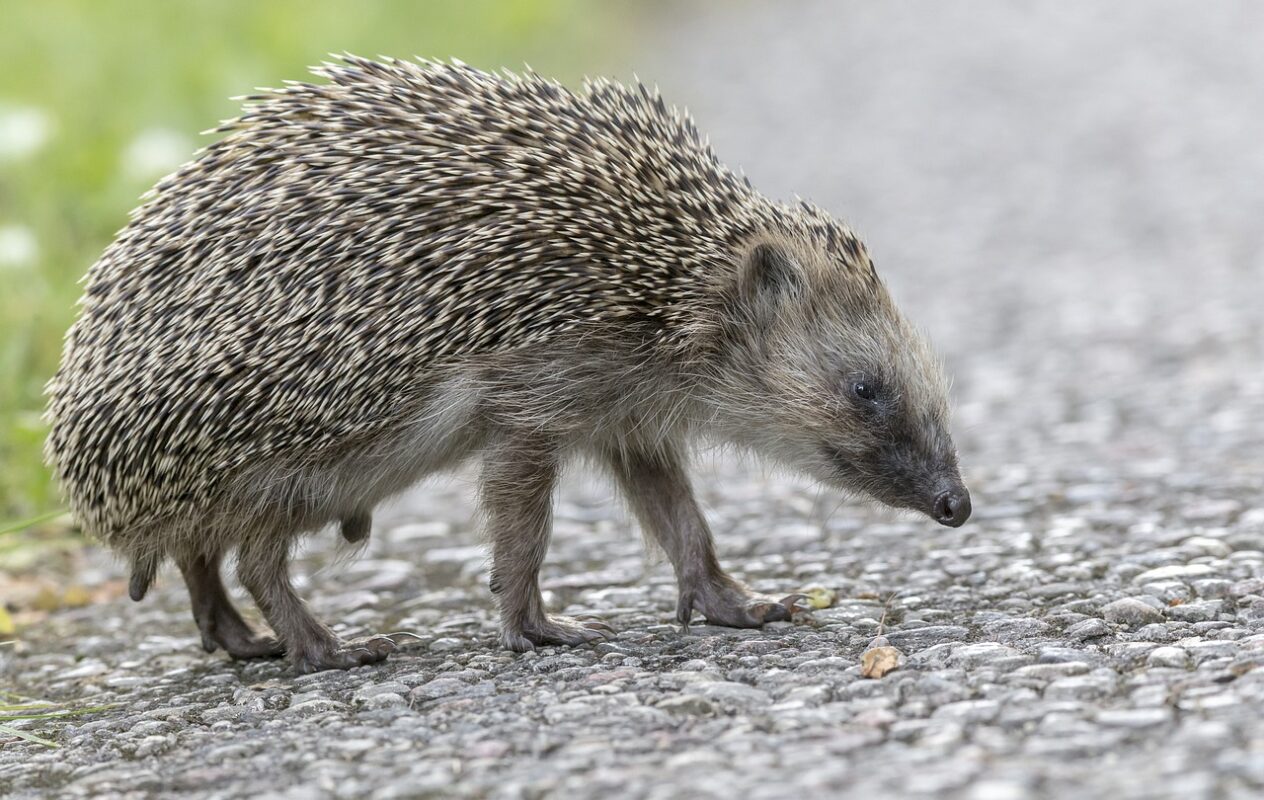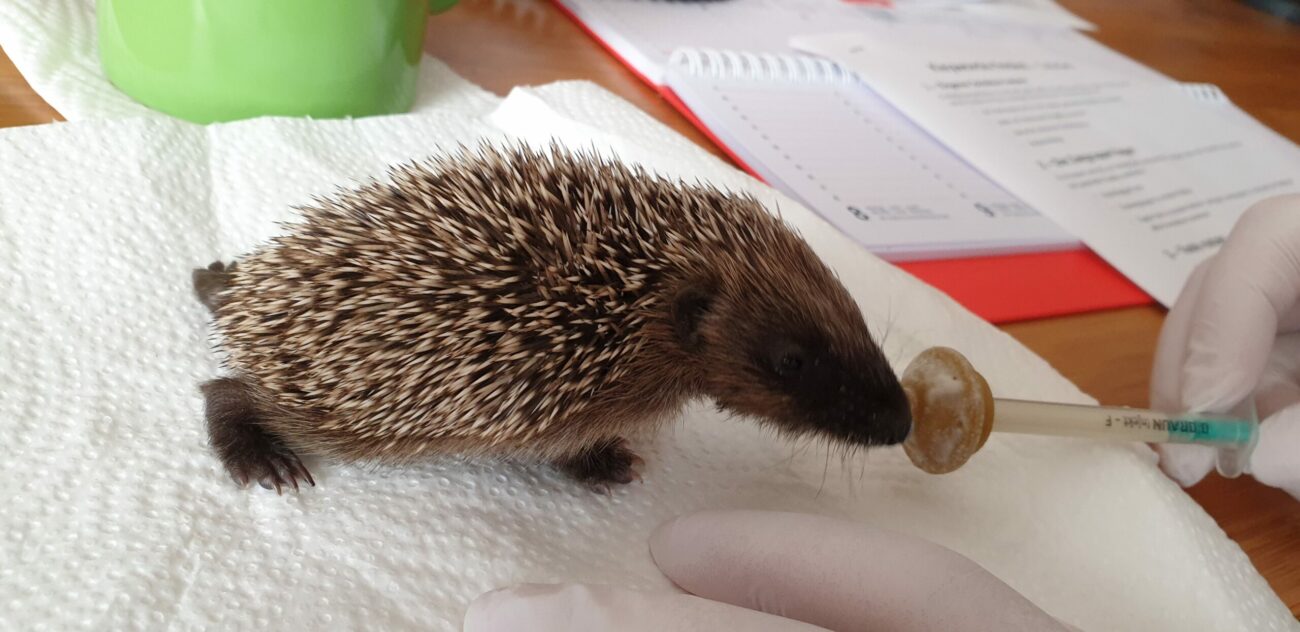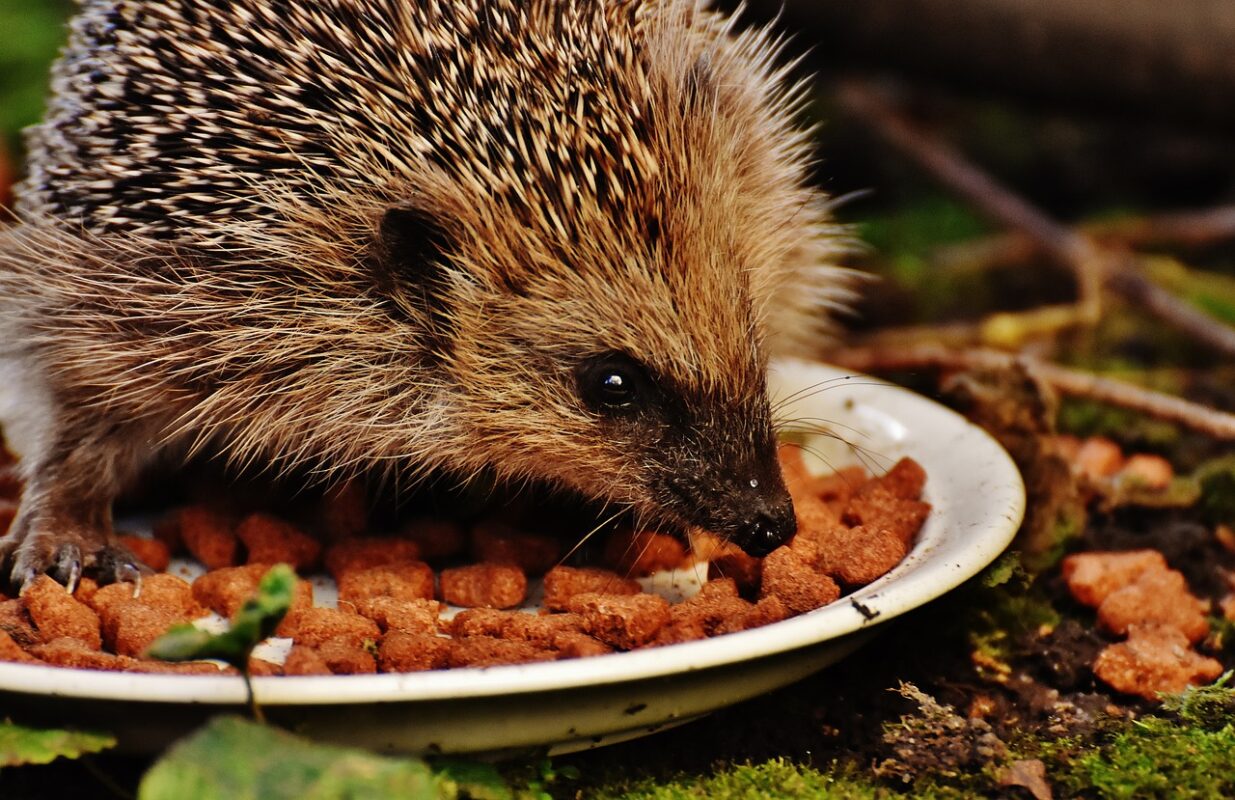Today — 2 February — is the official ‘Day of the Hedgehog’. This is surprising at first glance, as healthy hedgehogs lie hidden in deep hibernation at this time of year. It is only in April, when temperatures no longer fall below 10° C at night, that it is time for them to ‘wake up’!
Unfortunately, however, the inappropriate timing of ‘Remembrance Day’ seems to make more and more sense. Because like all insectivores, our small, prickly garden goblins have been in a dramatically bad situation for some years now. They suffer terribly and the suffering increases with every year.
And so it is that now — in February — hedgehogs can already be seen again. These are animals that have already gone into hibernation malnourished and suffering and are now waking up because ‘their supplies’, their strength, have run out prematurely. Such animals that are found now are usually seriously ill and then need expert help from experienced ‘hedgehog rescuers’!
But why exactly is it that our once favourite, ground-bound garden animal is suffering so much?
The dying out of garden culture
For a long time, hedgehogs benefited from our beautiful garden culture: the gardens were surrounded by bushes and a few trees that provided privacy when sitting on the patio on warm summer evenings. Songbirds fluttered in the bushes, picking a few rowan berries, ivy berries or nibbling the last bits of seed from a pretty bird house and singing their evening greeting. As soon as the blackbirds fell silent, the first bats took over the flight space above the terrace and made sure that the mosquitoes didn’t become too intrusive. And while the fireflies gathered between the bushes, the little prickly knights began to rustle below, burrowing through the leaves under the bushes and collecting bugs and grubs.
The hedgehogs even plundered poorly hidden nests of mice or even rats. Every garden owner was therefore delighted to have these ‘four-legged helpers’. In fact, our native brown-breasted hedgehog was more widespread in gardens and parks than in the countryside, where increasingly intensified agriculture made it more and more difficult for the spiny animals to survive: The hedgerows between the fields with their strips of bushes, where hedgehogs originally had their ideal habitat, became fewer and fewer.
Studies clearly show this trend in favour of gardens. In recent surveys, the population density in cities was higher than in agricultural landscapes. In the meantime, hedgehogs can even be found in the more inhospitable surroundings of city centres.
Lack of food, lack of habitat, lack of hiding places
But for some years now, our hedgehogs have hardly been able to make ends meet, even in gardens and parks. The main reason for this is a lack of food. Hedgehogs are highly specialised insect eaters. They travel an average of 3 kilometres per night in search of nocturnal ground beetles, beetle larvae and caterpillars. But there are hardly any of these insects left:
The number of insects in Germany has not only declined, it has actually collapsed: Three-quarters of all flying insects have disappeared in the course of less than thirty years, according to the shocking findings of one of the most relevant studies on the subject: in just 27 years, the total mass of insects counted decreased by 76 per cent, report scientists from Germany, the UK and the Netherlands in the journal ‘PLOS ONE’ in October 2017.
Source (german): https://www.br.de/rote-liste/insekten-insektensterben-insektenschwund-bienen-schmetterlinge-grillen-kaefer-100.html
In its distress, the hedgehog turns to ‘substitute food’, such as snails and earthworms. Unfortunately, however, this emergency food makes hedgehogs ill, because snails and earthworms transmit dangerous parasites. Parasites in themselves are not a bad thing for hedgehogs – every wild animal carries parasites on and in itself and this is also the case with hedgehogs. As a rule, parasite and host animal are very well adapted to each other in nature (many hedgehog parasites cannot live without hedgehogs!) and so a healthy animal with a strong immune system usually copes well with them.
Although hedgehogs obtain over 90 % of their energy requirements (in a healthy landscape) from insects and only a very small percentage from snails (1 %) and earthworms (8 %)[1], the proportion of the latter was already higher in phases when beetles are not yet or no longer as available – i.e. in spring and late autumn. However, due to the collapse in insect numbers, hedgehogs are now lacking their basic diet and are increasingly forced to switch to unhealthy emergency food. The consequences are dramatic:

Malnourished, malnourished, massive introduction of parasites
This is because by eating more and more ‘bad’ food such as snails and earthworms (but also rubbish), the animals suffer not only from malnutrition, but also from a malnutrition in which important substances are missing (e.g. the chitin of the beetles in the intestine acts as a natural ‘medicine’ against parasites during digestion) — and in addition, with every bite, more and more parasites migrate into the hedgehog and come up against an immune system already weakened by the poor nutritional status.
The Immune system can no longer cope with such an input. As a result, most animals increasingly suffer from over-parasitisation, they find it very difficult to breathe and/or suffer from fatal intestinal inflammation. Added to this is a ‘new’ parasite that has only been spreading in Germany for a few years, which is transmitted by snails and is a serious problem for hedgehogs, the so-called intestinal suction worm (Brachylaemus erinacei).
But the insect shortage is man-made: Our gardens are becoming increasingly ‘poorer’. Fewer bushes, fewer trees, exotic plants and double flowers that do not produce nectar: As a direct consequence, this also means fewer insects. Because every butterfly (as a caterpillar) needs a food plant that it can eat. Every beetle needs a bush, some dead wood and a layer of leaves in which it can hide and reproduce. And our hedgehog also needs a shelter, an untouched spot in an ‘untidy’ corner of the garden where it can hibernate undisturbed under leaves and branches between October and April. Where are they supposed to find this when more and more gardens are becoming increasingly ‘naked’, monotonous and free of natural structures, and when absolutely lethal gardening tools such as robotic lawnmowers, sickle trimmers and leaf vacuum cleaners or blowers are often used?
Garden culture has changed; where once the natural oasis was enjoyed with birdsong, the buzzing of bees and the rustling of bushes, today the focus is on a ‘functional place’ – less a garden, more an enlarged terrace or a green area that is more like an open conservatory than a piece of living nature.
Entire populations under threat
As a result, not only have studies found an enormous decline in hedgehog populations in Germany, but unsurprisingly the average life expectancy of the animals is also falling. Although a hedgehog can normally live to be around 7 years old in the wild – and even 16-year-old hedgehogs have been found[2] – current studies show an average life expectancy of less than two years for native brown-breasted hedgehogs (data for Denmark, same source).
In addition, there is a high death rate among the babies – data from 1977, which was still a ‘good time’ for hedgehogs, showed that an average of 20% of the pups died before they left their litter nest at the age of around one month, and 70% died within their first year of life[2]. Together, these two factors mean that entire populations are now collapsing.
This can also be seen in the everyday life of hedgehog rescue centres. Unlike in other countries, there are practically no state structures for the care of wild animals in Germany. As a result, wild animal welfare practically rests solely on the shoulders of private individuals who devote a lot of time (and money) to helping animals in need. For the past 2-3 years, however, hedgehog rescue organisations have been faced with a veritable flood of new arrivals and, in addition to the ever-increasing number of emergencies, the condition of the animals handed in is also becoming increasingly dramatic.
Based on this data, we are about to lose our ‘knights of the night’ completely in many areas sooner or later. And if we allow this to happen, it may be too late for them, even if we — hopefully! — succeed in improving our nature again. Reintroducing extinct species is very difficult…
How to help the friendly garden goblins
So what can you do to protect these wonderful little guys? It’s actually quite simple: just as bird lovers have long realised that our songbirds need help by providing them with nesting aids and healthy food, hedgehogs can also be helped by providing them with a habitat – and healthy food, at least in times of scarcity.
High-quality cat food is best suited for healthy supplementary feeding; it should definitely be grain-free and have a high meat content, at least 60%. Adapted to their insect-heavy diet, hedgehogs have an extremely short and less tortuous intestine. They are therefore dependent on a diet consisting almost entirely of protein. They cannot digest cereals or plant-based food in general, let alone nuts, and are more likely to suffer from stomach ache. Irritatingly, practically all food mixtures labelled as ‘special hedgehog food’ are therefore completely unsuitable for hedgehogs. You can definitely save yourself the money!
Just like when feeding birds, the hedgehog feeding place should always be kept clean. If you want to make sure that only Mr and Mrs Hedgehog (can) help themselves, use a hedgehog feeder. These are even available to buy with a transparent front, and if you then set up a night-vision-capable wildlife camera, you have your own nature television programme!
Supplementary feeding can prevent ‘your’ hedgehogs from eating too much bad food in the form of snails and worms. You prevent fatal malnutrition and thus support the immune system so that the animals can cope better even if they eat snails and worms on the side. In the baby season, which is normally in August but has often been brought forward recently due to the warm phases in spring), supplementary feeding helps the mother animals to provide their babies with sufficient food.

Did You Know?
Did you know that hedgehog mums are real super mums? If they can, they suckle their babies until they weigh around 300 g! Unfortunately, hardly any mother hedgehogs in the wild manage to do this and many wear themselves out caring for their babies to such an extent that they die before the babies are viable on their own or shortly afterwards.
Reliable watering places are just as important as food. Of course, the best thing is to have a garden pond: In our increasingly hot and dry summers, not only do many animals benefit from this (please think about exit aids): Ponds provide a greatly improved microclimate all around and so they also have a health-promoting effect for us humans thanks to increased humidity and the resulting reduction in dust pollution.
Beetle cellar, hedgehog house & ‘hedgehog motorway’
To provide more insects with a habitat, you can also create beetle cellars. This is basically just a small pit, preferably under a bush, which you fill with dead wood. Here, beetles and other insects find a place to retreat and a place for their nursery. The construction is very simple: you dig a hole (up to 50 cm deep with walls that are not too steep if possible) and fill it with all kinds of dead wood. However, this should come from native tree and bush species, as wood from exotic trees is often ‘indigestible’ for our native fauna. You can find great instructions here.
And of course you can also offer your spiny goblins a home. Such houses should be around 30 cm high if they are also to be used for hibernation. Instead of buying it ready-made, you can easily make such a house yourself, e.g. with these instructions here: https://physalia.de/Download/Igel-Wohnhausbau.pdf
To ensure that the beady-eyed rustling kings can travel far enough in their nocturnal search for food to get their fill, allow them to pass through your fence. A 10 x 10 cm hole is enough for them to move quickly from garden to garden. In a bar fence, you can simply saw out a bar at the bottom (be careful not to create any sharp corners); with wire mesh, it is usually enough to wedge two bricks underneath at one point to create a gap between them. Some people build small gates/tunnels out of wood and decorate them as gates, the hedgehog-loving British even have a whole project for ‘hedgehog streets’.
If you can then persuade one or two garden owners in the area to make their gardens hedgehog-friendly too, perhaps hedgehogs will move back into your neighborhood – and with them, real garden culture!

Sources
[1] https://www.wildlifeonline.me.uk/assets/ugc/images/hedgehog_diet_composition_charts.png
[2] Dr. Sophie Lund Rasmussen, “The Danish Hedgehog Project”: 390 hedgehogs examined (roadkill & other remains), average age 1.82 years, age range: 0-16 years, nine individuals 9 years and older. Source: Presentation at the “First International Scientific Conference for Rehabilitators of European Hedgehogs” in Denmark, September 2020.
[3] Pat Morris 1977 in the “Journal of Zoology”, calculated on the basis of 76 maternal nests. Source: https://www.wildlifeonline.me.uk/animals/article/european-hedgehog-mortality-introduction

Header image: Alexas_Fotos via Pixabay.de


